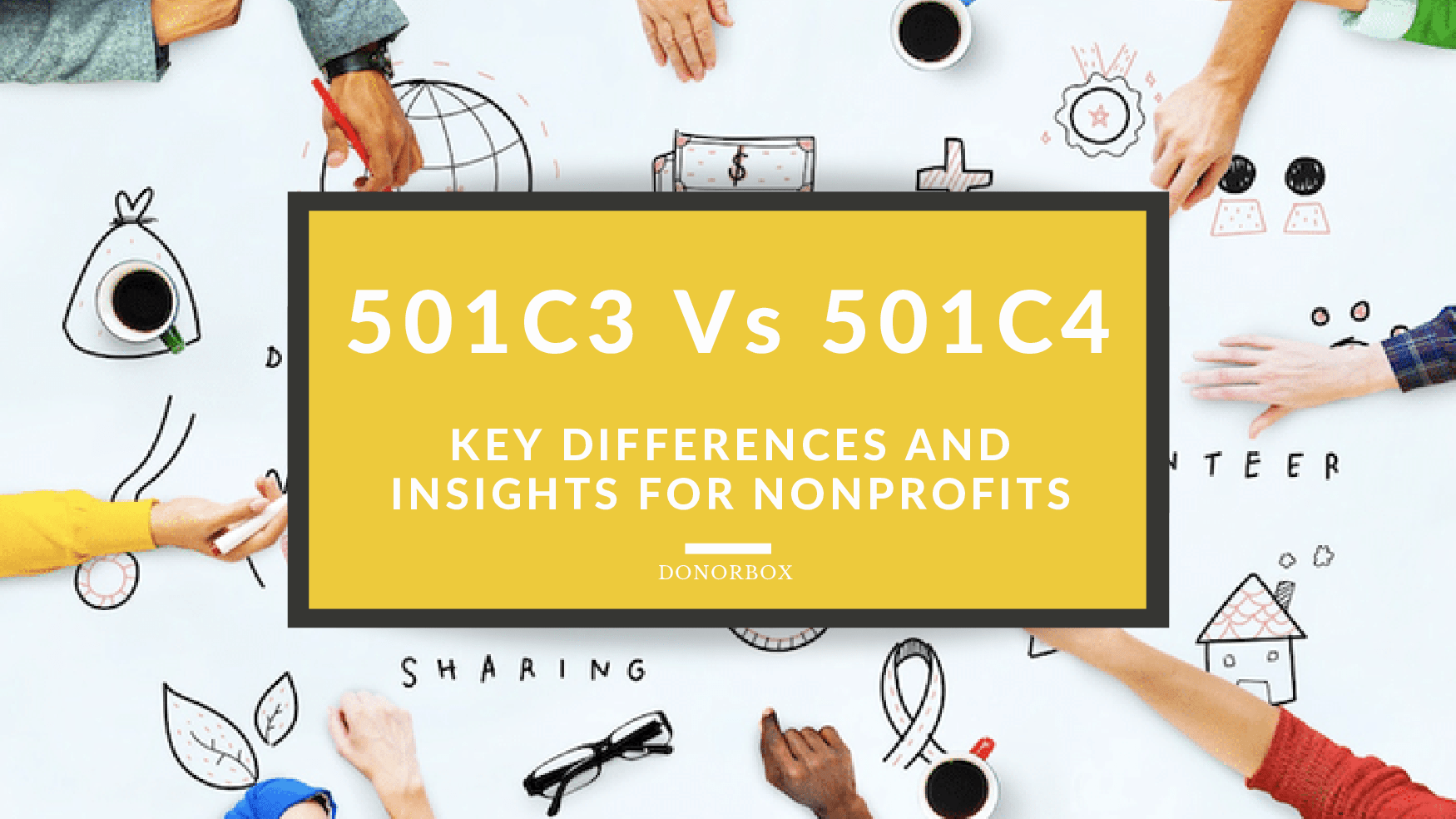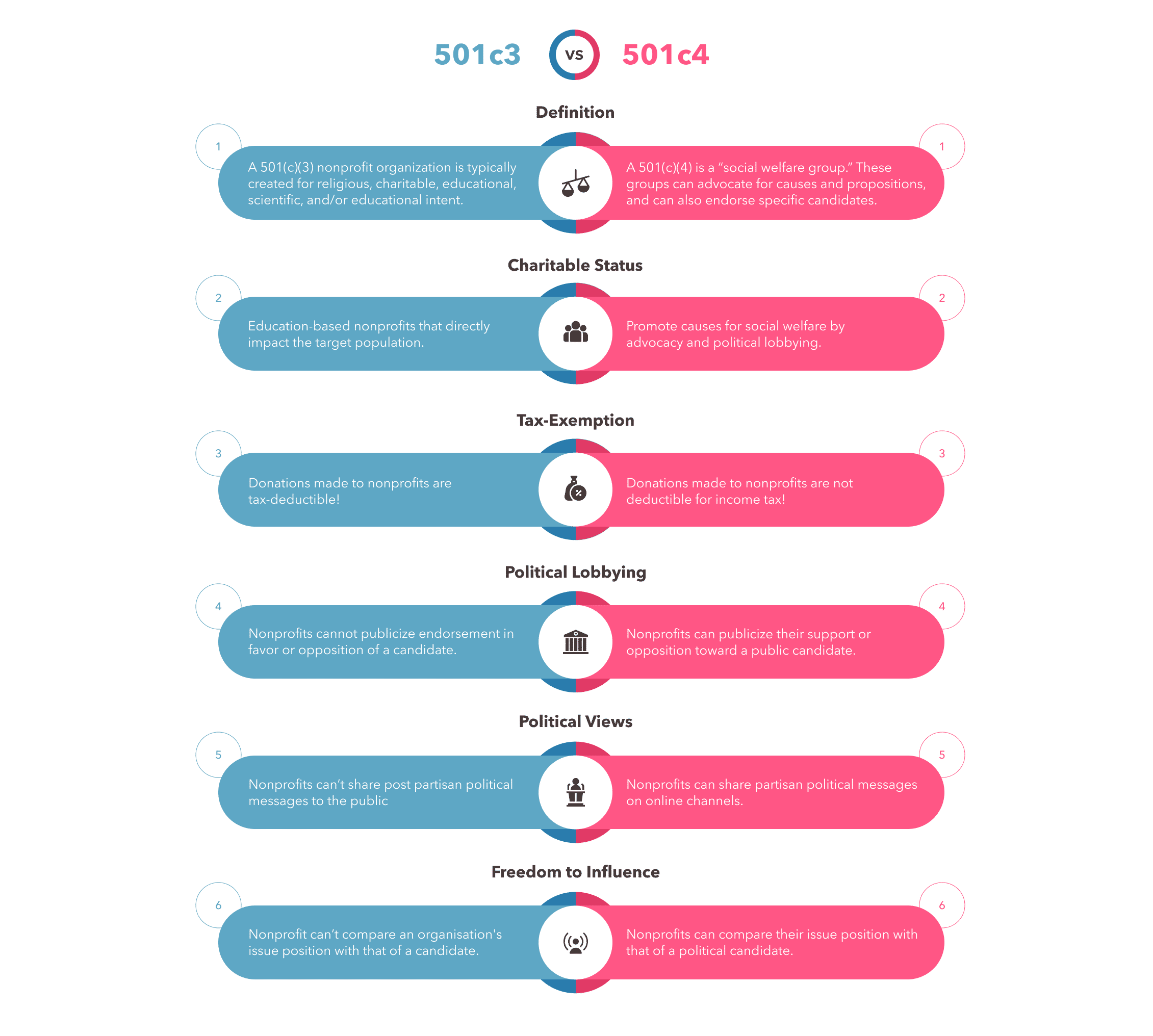What Type Of Nonprofit Are We - Direct Service Vs Educational Vs Religious

You have an outcome you feel passionately near. You've identified an unmet need and adamant an organizational solution. You have created your mission statement and recruited others who care about this effect to make a commitment to serve on your Lath of Directors. You're now hoping to interview employees and volunteers, as well as raise funds to support your cause.
Your soon-to-exist-incorporated nonprofit is set up to launch and is ready for official nonprofit status from the federal government. Simply you're faced with the question: do I file as a 501(c)(3) nonprofit or 501(c)(four)?
What is the deviation between the 2? While sure aspects of these filings are similar, there are key differences to take into consideration prior to applying. Your decision will alter the future of your organization.
What is the exact difference between a 501(c)(three) and 501(c)(iv)?
As per IRS, 501(c)3 is a nonprofit system for religious, charitable, scientific, and educational purposes. Donations to 501(c)3 are taxation-deductible. Whereas on the other mitt, 501(c)4 is a social welfare group, and donations to 501(c)iv are not tax-deductible.
Allow's understand 501(c)(3) and 501(c)(4) in more particular below:
What's a 501(c)(three)?
The Definition:
A 501(c)(three) nonprofit organisation is typically created for religious, charitable, educational, scientific, and/or educational intent. They are tax-exempt, carry research, and are express to an amount of lobbying, advocacy, or political activity. Donations to 501(c)(3) organizations are taxation-deductible. Churches, cancer inquiry and back up groups, women's shelters, and mentoring programs for at-risk youth are examples of 501(c)(three)groups.
What's a 501(c)(4)?
The Definition:
A 501(c)(4) is a "social welfare grouping" that can advocate for causes and propositions, similar 501(c)(three)s. However, 501(c)(iv)s can likewise endorse specific candidates – one of the well-nigh substantial differences between the ii. Examples of this status include political activity groups to advance reproductive or civil rights. While nonprofit organizations with this status are also tax-exempt, donations to 501(c)(four) groups are not tax-deductible.

An In-Depth Look
Charitable vs. Social Welfare Purposes
501(c)(3)s are advocacy and education-based. They often provide direct services to their target population. The types of services provided are broad and various, including food distribution through nutrient banks, medical research, after-school programs, health clinics, and mental health services.
These organizations raise public awareness near their causes, and may even teach and railroad train the public nigh them. They can push forrard and endorse legal measures such as propositions so long as they're relevant to the nonprofit's purpose.
Like to 501(c)(three)s, 501(c)(4)southward are considered social welfare organizations. They are tax-exempt from federal income taxes and aim to push their mission to the forefront of the public's consciousness. 501(c)(4)due south are allowed to become far more politically involved and partisan than 501(c)(3) organizations.
Lobbying
If a nonprofit organization focused on addressing and catastrophe racism learns that at that place is a candidate whose platform undermines their mission, their ability to accost this will vary based on their federal nonprofit status.
501(c)(3)s can coordinate nonpartisan go-out-the-vote, voter registration, and instruction drives, likewise as nonpartisan voter protection activities.
501(c)(4)s are unlimited in their abilities to lobby for and against the legislation, as well as support and oppose ballot measures. In 2010, the Supreme Court ruled for the 2010 Citizens United decision, allowing corporations and labor unions to register every bit 501(c)(4)due south, and therefore allow unlimited spending on politics with undisclosed donors through political activeness committees, or PACs.
Both 501(c)(3) organizations and those with 501(c)(4) condition are able to abet publicly for their causes, but considering 501(c)(4)s are allowed to lobby and abet in ways that 501(c)(3)south can't, 501(c)(iv)s accept more than flexibility in advancing their issues. They can pay for costs necessary to a political organization, compare their own mission with a candidate'southward, ask candidates to sign pledges on any effect, and back candidates that reinforce their mission.
Political Campaign Intervention
Equally a 501(c)(3), the nonprofit tin host a debate between all candidates to bring their views on race and equality to light, only they cannot endorse their candidate of choice. Every bit a 501(c)(iv), they would take the power to endorse a candidate whose views align with their mission, support his or her campaign, and focus on getting out the vote efforts. However, donations to their cause – should it take 501(c)(4) condition – would not be tax-deductible.
Restrictions of 501(c)(3)south and 501(c)(4)southward
501(c)(3)s cannot dictate which candidate receives which information—if they want to lobby, they must lobby all interested candidates. The same goes for renting mailings lists and locations to organizations, legislators, and candidates – they must allow every candidate to rent, not simply those they personally select.
Should these causes spread into the political realm, 501(c)(three)s but take a limited ability to influence legislation and ballot measures. 501(c)(3)s are not allowed to endorse specific candidates. The nonprofits may besides vox opinions of sitting elected officials, just they cannot make personal critiques of the individuals.
Similarities Betwixt 501(c)(three)s and 501(c)(four)southward
Sponsoring debates betwixt candidates regarding the nonprofit'south subject is immune so long as all candidates are invited and given the opportunity to speak on the issues. 501(c)(3)s can also give voter guides to the public with comparisons between candidates on views of the nonprofit's issue should the candidate endorse or condone an issue relevant to the 501(c)(3)s.
The nonprofits may likewise voice opinions of sitting elected officials, but they cannot make personal critiques of the individuals.
Examples of 501(c)(3)s and 501(c)(iv)s
Cystic Fibrosis Enquiry Inc. is a 501(c)(3) which endorses measures that are within the realm of their existing mission – for example, a state proposition to advance stem jail cell research. They exercise non endorse specific candidates – rather, they brainwash politicians on both sides of the political aisle to support legislation that will positively impact those living with cystic fibrosis and to vote against measures and bills that will impairment or negatively impact their constituents.
Ocean Champions is a 501(c)(4) environment organization that has a political action committee (Ocean Champions PAC). They describe themselves as "the but ocean group that helps elect the Members of Congress who fight for our oceans." By supporting members of congress, they are utilizing their abilities as a 501(c)(4) organization to support its mission
Tin 501(c)(3)s Have 501(c)(4)southward?
Many groups have managed to provide direct services and advance their missions as a 501(c)(3) organization, while also advancing their mission through the political arena by establishing a separate 501(c)(four) system that aligns with their mission.
One 501(c)(3) that also has an action fund is Planned Parenthood. While the arrangement itself is a nonprofit, advocating "for policy to expand access to health care," the nonprofit also has an activity fund arm: Planned Parenthood Activity Fund (PPAF). Through this PPAF, Planned Parenthood is able to "fight to advance and expand access to … health care and defend reproductive rights," as their mission states.
Conclusion: Cull What's Best for Y'all
Depending on your ultimate goal, conduct in-depth inquiry in guild to determine which filing works best for you. Whether you're looking to endorse candidates or simply lobby on an outcome relevant to your nonprofit, in that location is no incorrect answer. Practise your research, acknowledge your needs, and know that you're making a difference whether you lot're a 501(c)(3) or 501(c)(four).
As a nonprofit you will need funds in order to survive and operate, whether it is through grants, gifts, or donations- fundraising is an essential and continuous attempt for whatever nonprofit.
First maximizing your funds from the very beginning for your nonprofit by using effective and powerful tools and platforms like Donorbox.
Observe more nonprofit tips and resources at our nonprofit blog. If y'all're thinking to start a nonprofit in the Us, we also have dedicated articles for starting a nonprofit in different states in the US, including Texas, Minnesota, Oregon, Arizona, Illinois, and more than.
Get Started With Donorbox
Oftentimes Asked Questions (FAQs)
This section volition answer some common queries regarding 501(c)(3) and 501(c)(4) nonprofit organizations.
ane. Can a 501(c)(3) organization change into a 501(c)(4) arrangement?
A 501(c)(3) organisation cannot alter into a 501(c)(4) arrangement. But it tin can dissolve to create a new 501(c)(4) arrangement. The dissolution clause may preclude the former nonprofit to distribute its assets to the new ane, while still allowing to brand a grant with certain restrictions. Read more most it here.
2. Does my 501(c)(3) or 501(c)(4) nonprofit have to disembalm donors?
While filing course 990 returns, 501(c)(three) nonprofits need to disclose donor information for donations worth $5000 or more to the IRS. The private foundations under this status must likewise make their donor names available for public inspection. On the other hand, 501(c)(four) nonprofits are exempt from whatsoever disclosure.
3. Are donations to volunteer burn companies tax-deductible?
Volunteer fire companies are exempt as social welfare organizations when they actively engage in fire fighting and disaster assistance. Hence, donations made to their causes are tax-deductible, merely they must exist solely for the public benefit.
Note: Past sharing this information we [Donorbox] practice not intend to provide legal, tax, or bookkeeping advice, or to address specific situations. Please consult with your legal or tax advisor to supplement and verify what you larn here.

What Type Of Nonprofit Are We - Direct Service Vs Educational Vs Religious,
Source: https://donorbox.org/nonprofit-blog/501c3-vs-501c4
Posted by: cameronlacent.blogspot.com


0 Response to "What Type Of Nonprofit Are We - Direct Service Vs Educational Vs Religious"
Post a Comment